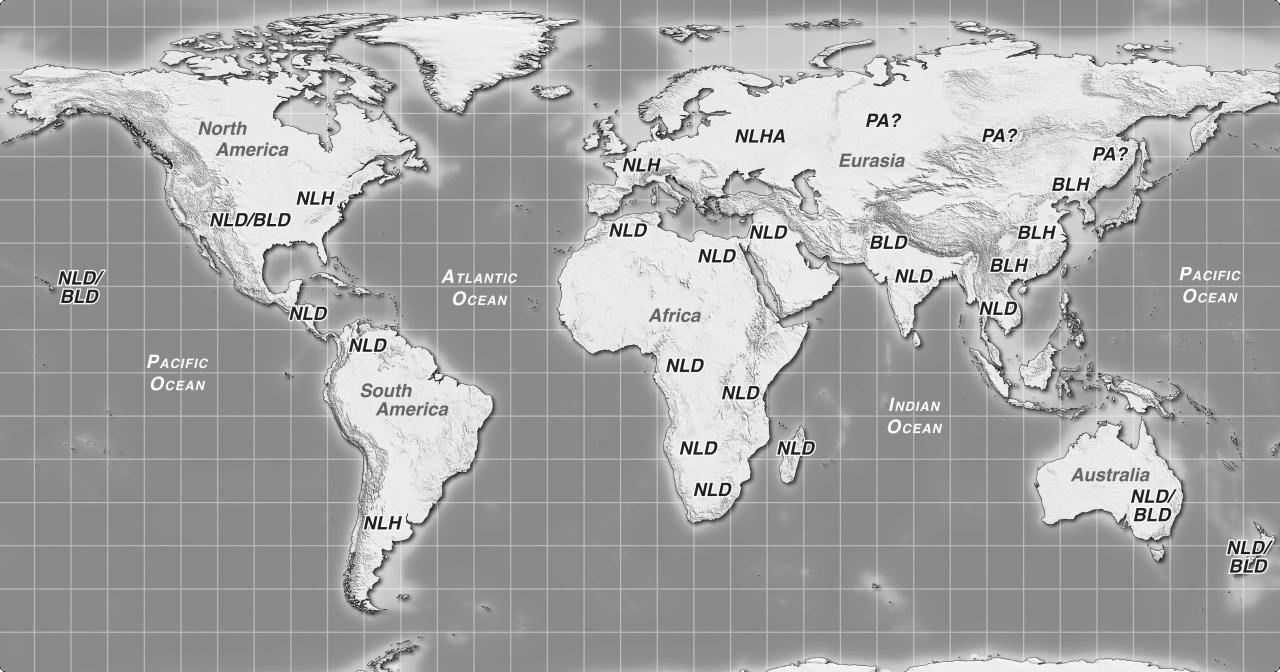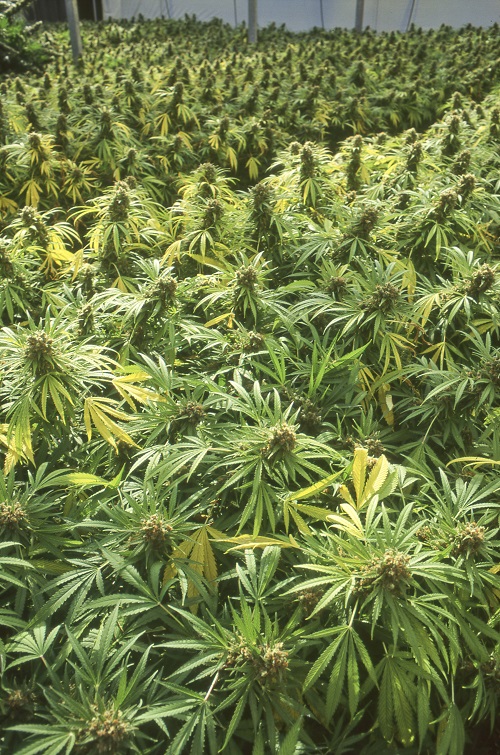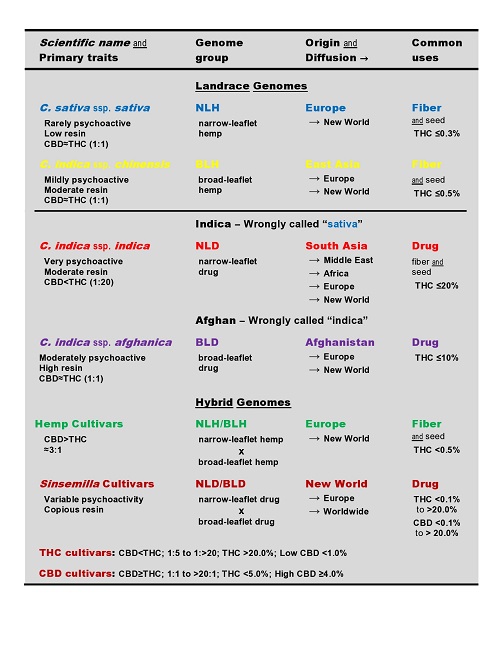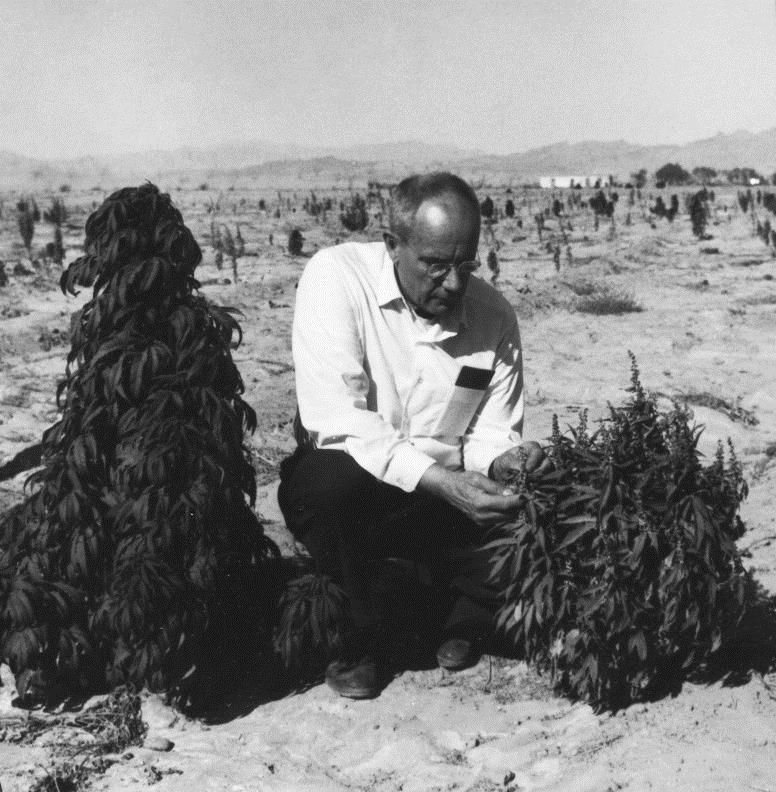|
Marijuana and hemp (Cannabis) and the closely related hop
genus (Humulus) are the only widely
known genera included in the small, but economically valuable, Cannabaceae
family. Swedish botanist Carl Linnaeus, the “father of modern taxonomy,” first published
the scientific name Cannabis sativa
in his seminal Species Plantarum of
1753. The Latin name Cannabis derives
from Greek (kannabis) and may
originally have been derived from Scythian. The term sativa simply means “cultivated” and describes the common hemp
plant that was widely grown across Europe in Linnaeus’ time. We, the authors,
consider C. sativa to be native to
western Eurasia and especially Europe, where, for millennia, the plant has been
grown for its strong fibers and nutritious seeds, and from where it was
introduced to the New World multiple times during early European colonization. Cannabis sativa plants also produce very
small amounts of the compound delta-9-tetrahydrocannabinol (THC), the primary
psychoactive and a medically valuable cannabinoid found only in Cannabis. Since C. sativa evolved within the geographical limits of western
Eurasia, it represents only a small portion of the genetic diversity seen in
the genus Cannabis worldwide.1


In 1785, European naturalist Jean-Baptiste Lamarck described and named a second species, Cannabis indica, meaning “Cannabis from India,” where the first
samples of the
highly psychoactive plant that
reached Europe originated. Cannabis
indica has the genetic potential to produce relatively large amounts of THC.
The species is used for marijuana and hashish production, but in many regions
of eastern Asia it also has a long history of cultivation for fiber and seed.
Humans make cloth out of C. indica
fibers and eat the seeds, but this native eastern Eurasian species is more
commonly used today well beyond its original geographical range as a drug plant
with widespread social and medicinal importance.1
 
While Karl Hillig, PhD, was a doctoral
student at Indiana University, he used morphological and chemical
characteristics to investigate the diversity of the Cannabis genus and proposed taxonomic groupings (subspecies) that
support the original two species concept.2-5 Hillig recognized
European cultivated Cannabis as a
separate species (C. sativa). Because
this species typically has narrow leaflets and is used primarily for hemp fiber
and seed production, we refer to it as narrow leaflet hemp (NLH). European C. sativa NLH populations are much less
genetically diverse than those found in many other regions.
Hillig assigned the
remainder of the world’s cultivated varieties to C. indica and divided them into three subspecies. One of these
subspecies, C. indica subsp. indica, includes varieties that span the
Indian subcontinent from Southeast Asia to western India and into Africa. These
traditional drug varieties produce abundant amounts of THC with little if any
cannabidiol (CBD). CBD is the second most common cannabinoid, and is
non-psychoactive, but it has been shown to be medically effective for a variety
of indications. By the 19th century, high-THC C. indica subsp. indica reached
the Caribbean region, and steadily spread throughout Central and South America.
Since the 1960s, C. indica subsp. indica has provided most of the drug cannabis
exported to North America and Europe. Marijuana users commonly call
domestically grown plants of these varieties “sativas” because their leaflets
are relatively narrow, and therefore exhibit a superficial resemblance to those
of European NLH plants. However, this is a misnomer as C. sativa plants produce little if any THC in our construct. Based
on Hillig’s
research, we now refer to members of C.
indica subsp. indica as narrow
leaflet drug (NLD) varieties. Although they have relatively narrow leaflets
like NLH (C. sativa) plants, the NLD
plants can produce an abundance of THC and are most commonly used for their psychoactive
effects. drug content. Based on taxonomic tradition, these plants are properly
called “indicas” rather than “sativas."  
A second C. indica subspecies
originated in Afghanistan where crops were traditionally grown to manufacture
sieved hashish, a mechanically concentrated Cannabis
drug. From 1974, when descriptions
and photos of Afghan Cannabis were
published by Harvard professor Richard E. Schultes, PhD, it became readily
apparent that it represented a type of drug Cannabis
previously unknown outside of Eurasia, belonging neither to Linnaeus’ C. sativa nor Lamarck’s C. indica.6 Its shorter, more
robust stature, and broad, dark green leaves easily distinguish it from the
taller, lighter green, and more laxly-branched NLD varieties. Because of its
limited geographical range and restricted usage, the Afghan genome is less
diverse than the NLD genome. By the late 1970s, seeds of Afghan hashish
varieties reached Europe and North America and were rapidly disseminated among
marijuana growers. At this time, all Cannabis
varieties were commonly considered to be members of a single species, C. sativa, and the familiar NLD
marijuana varieties were called “sativas” to differentiate them from the newly
introduced and quite different looking Afghan varieties commonly called
“indicas.” Hillig named them C. indica subsp. afghanica, which we now refer to as broad leaflet drug (BLD) varieties to
differentiate them from NLD varieties. On average, populations of BLD plants
contain approximately equal amounts of THC and CBD. Although BLD varieties are
also considered by us to be members of C.
indica, it is more correct to distinguish them from subspecies indica from India by calling them
subspecies afghanica, or simply
“Afghans."
Hillig’s third grouping within C. indica
is subspecies chinensis, which
comprises the traditional East Asian fiber and seed varieties and associated
feral populations. We refer to this group as broad leaflet hemp (BLH). Like
other subspecies of C. indica, varieties of C. indica subsp. chinensis
possess the genetic potential to produce psychoactive THC, but East Asian
cultural practices, such as Confucianism, have long encouraged the selection of
these varieties for their economically valuable fiber and seed, rather than
their psychoactive potential. As a result, total cannabinoid production is
lower than in subspecies indica and afghanica.
 
Evolutionary theory predicts that there must once have been a putative ancestor
of the two modern species C. sativa and
C. indica, often referred to as C.
ruderalis, which may have originated somewhere in Central Asia. However, by
now it is probably extinct, and seemingly ancestral populations are more likely
descendants of feral plants that escaped from cultivation long ago. Evolutionary
hypotheses based on plant distribution studies, paleoclimate modeling,
archaeological evidence, and the historical record propose that C. sativa NLH most likely originated in
a temperate region of western Eurasia, possibly in the foothills of the Caucasus
Mountains, from a putative hemp ancestor with diminished biosynthetic potential
to produce THC. Cannabis indica
likely originated in the Hengduan Mountains, in present-day southwestern China,
from a putative drug ancestor that had evolved enhanced ability to produce THC.
Early C. indica populations
diversified as they were introduced by humans to different geographical regions
where they
may have further evolved into the three
subspecies, all of which produce THC.1
Cultivated plant varieties are called cultivars, and when cultivars are grown
and maintained by local farmers
over generations, we refer to them as landrace cultivars, or landraces. Landraces
evolve in a balance between natural selective pressures exerted by the local
environment favoring survival, and human selections favoring a cultivar’s
ability to both thrive under cultivation and to produce particular culturally preferred
products. Early humans spread Cannabis
into many new regions as they moved, and, at each new camp or settlement, they
selected seed from superior plants within these early populations that were appropriate
for their own individual uses and processing methods. By sowing seeds from the
most favorable individuals, traditional farmers developed and maintained the
landraces upon which present-day hybrid hemp and drug cultivars were founded. 
Hemp cultivars were derived from crosses
between different European NLH landraces and East Asian BLH landraces.
Traditional Asian, African, and New World
drug landraces were, until relatively recently, all pure NLD types. Before
the introduction of BLD landraces from Afghanistan in the late 1970s, hybrids
between imported NLD landraces formed the core genome of domestically produced drug
cannabis in both
North America and Europe. It is through crossing NLD and BLD landraces from
such geographically isolated populations that modern hybrid sinsemilla (Spanish for “seedless”)
cultivars were created.1
Unfortunately, we cannot return today to a region previously known for its fine
Cannabis and expect to find the same
landraces that were growing there decades before. Cannabis is open-pollinated, with male and female flowers borne on
separate plants, and, therefore, two plants are usually required to produce a
seed. Random combinations of alleles (forms of a gene) and accompanying
variation are to be expected. Cannabis
landrace varieties are best maintained by repeated natural and human selection in
situ — nature selecting for survival
and humans selecting for beneficial traits. Without persistent human selection
and maintenance, these landrace varieties will tend to drift back to their
atavistic, naturally selected survival mode.
 
The Western world began using imported marijuana and hashish in the 1960s and all the remarkable imported
varieties available then were traditionally maintained landraces. Within a
decade, the demand for quality drug Cannabis
exceeded traditional supplies, and mass production in the absence of selection
became the rule. Rather than planting only select seeds, farmers began to sow
all their seeds in an effort to supply market demand, and the quality of
commercially available drug Cannabis
began to decline. In addition, travelers returned to the supplying nations and
introduced seeds of “improved” Western sinsemilla
varieties that interbred with the local landraces and thus contaminated the
local genomes. Landraces can no longer be replaced; they can only be preserved.
The few remaining pure landrace varieties in existence now, some kept alive for
decades as seeds and cuttings, are the keys to future developments in drug Cannabis breeding and evolution. It will
be a continuing shame to lose the best results of hundreds of years of
selection by local farmers. After all, our role should be as caretakers
preserving the legacy of traditional farmers for the future benefit of all.
Cannabis
research is a work in progress, and not all researchers agree on a single
taxonomy.7 DNA sequencing is currently being used to characterize
the diversity of many plant and animal groups, including Cannabis. While our knowledge grows and the evolutionary history of
Cannabis is revealed, changes in
taxonomic nomenclature will continue to reflect our deepening understanding of
this medically valuable, yet controversial, plant. More broadly, whether we
discover that Cannabis plants belong
to one or more species, we can be sure that humans have long known, used,
dispersed, cultivated and artificially selected these plants to perpetuate a truly
wide range of diversity.


Robert C. Clarke is the author of several Cannabis science books and has traveled
extensively throughout Eurasia documenting traditional Cannabis production and use. His breeding interests include
selection and preservation of landrace varieties, and developing narrow leaflet
drug varieties and hashish cultivars. Clarke is the executive director of
BioAgronomics Group, a cannabis industry consultancy, serves as projects manager
for the International Hemp Association, and holds a seat on the Phylos
Bioscience Cannabis Evolution Project
scientific advisory board. He may be contacted at rob@bioagronomics.com.
Mark D. Merlin, PhD, is a professor in the Botany Department of the University of
Hawai`i at Mānoa and an elected member of the Linnean Society of London. A
large part of his long-term biological and historical research has involved
drug plants and their past and present uses by people. He has authored or
co-authored a number of books on this general subject, such as Man and Marijuana: Some Aspects of their
Ancient Relationships (Fairleigh Dickinson University Press, 1972), On the Trail of the Ancient Opium Poppy
(Associated University Presses, 1984), Kava:
The Pacific Drug (Yale University Press, co-authored with Vincent Lebot and
Lamont Lindstrom, 1992), and, most recently, Cannabis: Evolution and Ethnobotany (RC Clarke and MD Merlin,
University of California Press, 2013). He may be contacted at merlin@hawaii.edu.
References
- Clarke
RC, Merlin MD. Cannabis: Evolution and
Ethnobotany. Berkeley, CA: University of California Press; 2003.
- Hillig
KW. A chemotaxonomic analysis of terpenoid variation in Cannabis. Biochem Syst Ecol. 2004;32(10):875-891.
- Hillig KW. A multivariate analysis of
allozyme variation in 93 Cannabis accessions
from the VIR Germplasm Collection. J
Indust Hemp. 2004;9(2):5-22.
- Hillig KW. Genetic evidence for speciation
in Cannabis (Cannabaceae). Genet
Resour Crop Ev. 2005;52(2):161-180.
- Hillig KW,
Mahlberg PG. A chemotaxonomic analysis of cannabinoid variation in Cannabis
(Cannabaceae). Am J Bot. 2004;91(6):966-975.
- Schultes RE,
Klein WM, Plowman T, Lockwood TE. Cannabis: An example of taxonomic
neglect. Bot Mus Leafl Harv Univ. 1974;23(9):337-364.
-
Small E. Evolution and
classification of Cannabis sativa
(marijuana, hemp) in relation to human utilization. Bot Rev. 2015;81(3):189-294.
|